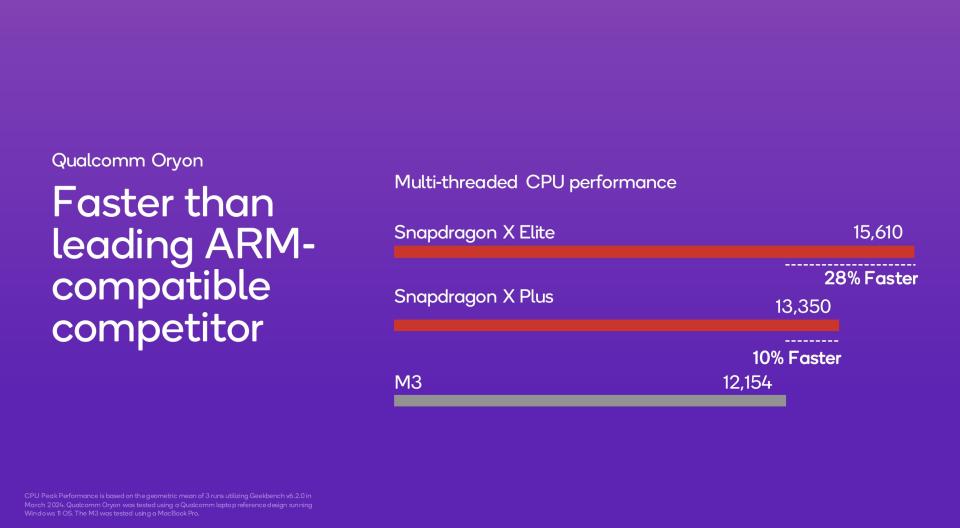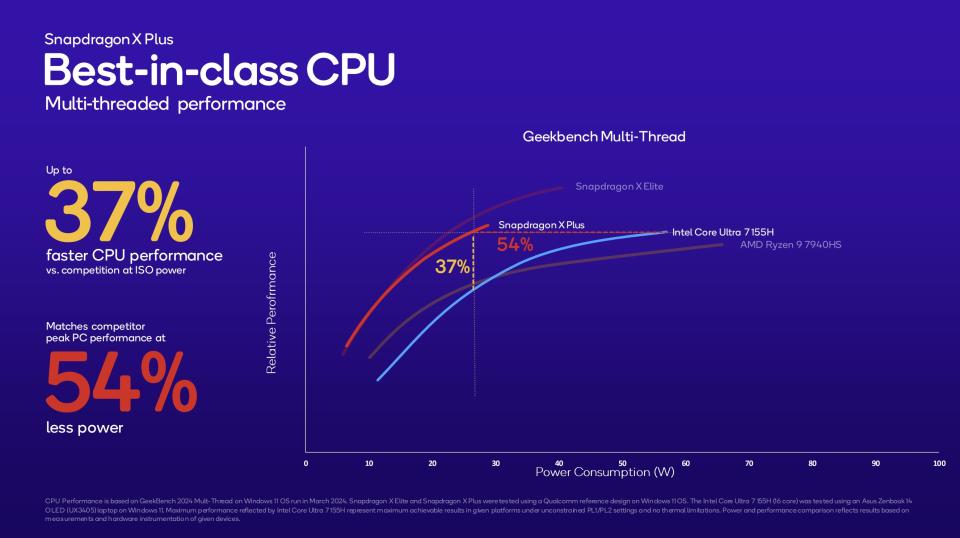What is Snapdragon X Plus? A look at Qualcomm's more affordable Arm laptop processor.

Quick answer: The Qualcomm Snapdragon X Plus is an ARM64 SoC — with Oryon CPU, Adreno GPU, and Hexagon NPU — from the same family as the Snapdragon X Elite. Qualcomm's X Plus should be a more affordable option that complements the X Elite, bringing a CPU with 10 cores and otherwise similar features for Windows on Arm laptops.
What is Snapdragon X Plus?

Announced April 24, 2024, the Snapdragon X Plus is a Qualcomm SoC with a 10-core Oryon processor (CPU), Adreno integrated graphics (GPU), and Hexagon Neural Processing Unit (NPU). It's expected to launch alongside the X Elite "mid-2024." It should provide laptop makers with a more affordable option that can nevertheless provide strong performance for everyday computing, gaming, and AI acceleration.
Unlike the X Elite, which has now been revealed to contain three separate SKUs, there is just one X Plus SoC with model number X1P-64-100. That doesn't mean that Qualcomm won't scale its X Plus chip further, and we might one day see SKUs with more or fewer cores across the Snapdragon X SoCs.
Digging into the details, the Snapdragon X Plus platform contains a Qualcomm Oryon ARM64 CPU with 10 cores, 42MB cache, and clock speed up to 3.4GHz. Its integrated Adreno GPU can handle up to 3.8 TFLOPS of performance, nearly matching that of the Xbox Series S and its 4 TFLOPS. This should allow for smooth Windows gaming even with the required emulation.
The platform supports up to 64GB of LPDDR5x RAM, with an 8,448 MT/s transfer rate and 135GB/s bandwidth capabilities. As expected in modern laptops, M.2 PCIe 4.0 NVMe solid-state drive (SSD) storage is supported.
Those interested in AI PCs — those with a new CPU, GPU, and NPU — should be excited about Qualcomm's Hexagon NPU. It offers 45 TOPS of performance for local AI acceleration, easily beating the current offerings from Intel Core Ultra (10 TOPS) and AMD Ryzen 8040 (16 TOPS) CPUs. Considering Microsoft has stated that local Copilot will require at least 40 TOPS of NPU performance, you won't have to wait for the next-gen Intel and AMD chips to hit the benchmark.
Here's a closer look at the specifications that make up the Snapdragon X Plus (X1P-64-100).
Extra features and specifications don't differ much from the X Elite platform, which is good news for anyone who doesn't want to spend as much on a laptop.
You still get support for three concurrent displays at a 4K resolution and 60Hz refresh rate, AV1 encoding and decoding for 4K HDR video, "enterprise-grade" security, and a Micro NPU for a "Sensing Hub" that offers human presence detection.
A Snapdragon X65 modem is included for 5G connectivity, and there's support for up to Wi-Fi 7 and Bluetooth 5.4 LE.
ARM64 vs. x86-64

Like the Snapdragon X Elite, the X Plus is an ARM64 processor built with an architecture that's different from the x86-64 CPUs from Intel and AMD. If you've used a smartphone you've used an ARM processor, with the technology making the jump to laptops more recently.
The tech is still fairly rare in laptops, as evidenced by the limited options in our collection of the best Windows on Arm laptops. That's expected to change in a major way with the release of Qualcomm's X platforms, and some users are no doubt concerned about app compatibility on the different architecture.
Apps created specifically for x86-64 systems can't be read by ARM64 systems, and vice-versa. That means you can't just download your favorite app compiled for an Intel or AMD system and expect it to work on an ARM-powered laptop. However, emulation and app makers taking the initiative to compile their software specifically for ARM64 removes most of the worry about compatibility.
Windows Central Editor Ben Wilson has a great article explaining ARM PCs and Windows 11 app compatibility, and he goes into depth about what you can expect when it comes to emulation performance.
The bottom line is that Windows on Arm is in a great place, having come a long way since it was first introduced. You might experience an occasional hiccup when working with emulation layers, but that shouldn't dissuade you from a Windows on Arm laptop. The performance and efficiency should far outweigh any temporary setbacks you experience.
Snapdragon X Plus vs. Apple and Intel

It's no secret that Qualcomm is happy to show off X1 Elite performance metrics compared to Apple's M-series processors. We know that the top SKU of the X1 Elite can beat the Apple M2 in performance and efficiency, and it can even hold strong against the Apple M3 and M3 Pro chips. So where does that leave the more budget-friendly X Plus?
Looking at Qualcomm's claims (which should be taken with some caution as we haven't tested first-hand), the X Plus is still 10% faster than the Apple M3 in multi-threaded Geekbench 6.2 tests despite having fewer cores and a lower maximum clock speed.
The M3 Pro and M3 Max can still easily beat the Oryon CPU in the X Plus, but, as mentioned, the X Elite is where you should be looking if you want to compare Apple's higher-end chips.

Apple's M-series processors have set the standard to beat when it comes to laptop power and efficiency, with Intel and AMD largely playing catchup in those areas. That appears to remain true now that Qualcomm has re-entered the race.
Qualcomm claims that the Oryon CPU in the X Plus is 37% faster than the Core Ultra 7 155H while consuming 54% less power in multi-threaded Geekbench tests. In Cinebench 2024 multi-threaded tests, the X Plus looks to perform 28% faster while using 39% less power compared to the same Intel CPU.
AMD's Ryzen 9 7940HS is also included in Qualcomm's comparison graphs, though it scores even lower than the Core Ultra 7.
Qualcomm also claims that the Adreno integrated GPU in the X Plus offers 36% better performance with 50% better efficiency in the 3DMark Wildlife Extreme benchmark, as compared to the integrated Arc graphics in the Core Ultra 7 155H.
How does the X Plus differ from the X Elite?
The Snapdragon X Plus is expected to launch as a more affordable alternative to the Snapdragon X Elite. While it will offer parity between wireless connectivity, display and video support, security measures, and more, the real difference comes down to CPU core count, frequency, and available boost.
All three of the X Elite's SKUs offer a CPU with 12 cores, while the X Plus has 10 cores. The multithreaded frequency differs, with the top X1E-84-100 chip hitting 3.8GHz while the other X Elite chips and the X Plus top out at 3.4GHz. There's a dual-core boost ability in the top two X Elite SKUs, whereas the baseline X Elite (X1E-78-100) and the X Plus have no boost ability.
The X Elite and the X Plus platforms are expected to launch at the same time, which means we should see four new CPUs make their way into Windows on Arm laptops "mid-2024." Details are still limited, but we're expecting ARM-powered Surface Pro 10 and Surface Laptop 6 announcements in May. There was even a recent leak involving a Surface Pro 10 with Snapdragon X Plus, suggesting that the 2-in-1 laptop will offer both X Elite and X Plus chips.
COMPUTEX 2024 is also looking like a prime place for Qualcomm and OEMs to show off some new hardware. The event kicks off on June 4, and it will feature a keynote from Qualcomm CEO Cristiano Amon.

